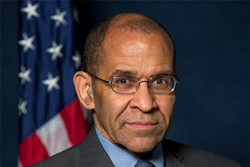Project & Program Updates
Chris Hart Advances Safety for All
Chris Hart's multi-faceted career reflects a common thread. That thread is safety and the aspiration to make the world a better place.
"My mother told me the first thing she ever saw me draw was an airplane. I became big on safety decades ago and have pursued it ever since," said Hart, who added that his mother was a teacher and his father worked in housing and urban redevelopment. It was a given that "if you've got skills, talent and energy that can be used to do good things, you use them to make life better for everybody."
Hart is a lawyer, former government official, pilot, transportation safety expert, and founder of Hart Solutions LLC, where he works as a consultant to help improve the safety of automation in motor vehicles, aviation and other transportation modes, workplace safety, and process safety in potentially hazardous industries, most recently including healthcare. What these industries have in common is the importance of doing things right the first time every time, and they are often not forgiving of errors.
He holds Bachelor of Science and Master of Science degrees in aeronautical engineering, both from Princeton University, and a J.D. from Harvard Law School.
He is Chairman of the Washington Metrorail Safety Commission, which he has served for the last five years to improve the safety of the Washington, D.C., area subway system, and is a former assistant administrator of system safety and deputy director of the Federal Aviation Administration.
Hart's passion for flying is in his blood. In 1926, Hart's great uncle, James Herman Banning, was the first African American to receive a pilot's license issued by the United States government. Hart himself is a licensed pilot with commercial, multi-engine, and instrument ratings.
In 1990, he was nominated by President George W. Bush and confirmed by the Senate to serve as a member of the National Transportation Safety Board (NTSB) and in June 2014 he was nominated by President Barack Obama to serve as the chairman of the NTSB. He served for three terms on the NTSB in several positions including as a board member, vice chair, and chair.
While at the FAA, he read the U.S. Institute of Medicine's landmark "To Err is Human: Building A Safer Health System" report, published in November 1999, which asserted that the prevalence of medical error is not caused by bad people in health care, rather good people working in bad systems that need to be made safer.
"That's when the light bulb lit for me that – wow – the safety protocols we use that are so successful in aviation are applicable to other industries, including not only healthcare, but also nuclear power, chemical manufacturing and refining, you name it. That report really got me started on healthcare safety," Hart said.
In his career in the skies and in prominent safety circles on the ground, Hart has played an important role in breaking down some major barriers.
"One of the big problems in aviation has been centuries of maritime tradition where nobody challenged the captain, and everyone spoke to the captain only when spoken to. There was a huge vertical authority gradient. Aviation did that for a long time until we started seeing accidents relating to people who didn't challenge the captain even when they were sure something wasn't right, including the worst accident in aviation history, with 583 fatalities," Hart said.
He added another important factor in changing outcomes is changing the environment to be more collaborative, open to discussing and sharing information about errors and near misses so that they don't occur again.
Heightened awareness of and commitment to minimizing potential single point failures has had a sizeable impact on the safety of flight which can be translated to health care. Another safety hazard arises in healthcare when hospitals have equipment from different manufacturers that perform the same function but have different controls. He likens it to the increased likelihood of car crashes if car manufacturers didn't all put the gas and brake pedal on the same side.
"Humans in healthcare are already trying their best. They're passionate about doing good, and their credo is to do no harm. But humans are imperfect and make mistakes. Once you admit that, you can put your focus on not only improving the human but, as noted in the IOM report, "To Err is Human," improving the systems that they use."
"The bottom line is there are huge opportunities for the industry to learn from each other. Even though health care is far more complex and variable than aviation, there's a lot to be learned."
As a member of the Patient Safety Full Court Press team, Hart said one of the distinguishing characteristics of the Foundation is that it's not in denial that there is a problem in health care. Reports show there are 250,000 preventable error deaths every year in the U.S. and that one in four receiving health care in the U.S. experience harm.
"That's a public health disaster. What I like about the Foundation is its recognition that, yes, there are major problems that need to be fixed and there are things we can do to make this much better. There are ways to move the needle significantly and sustainably."
Related Posts
By accepting you will be accessing a service provided by a third-party external to https://www.jhf.org/
